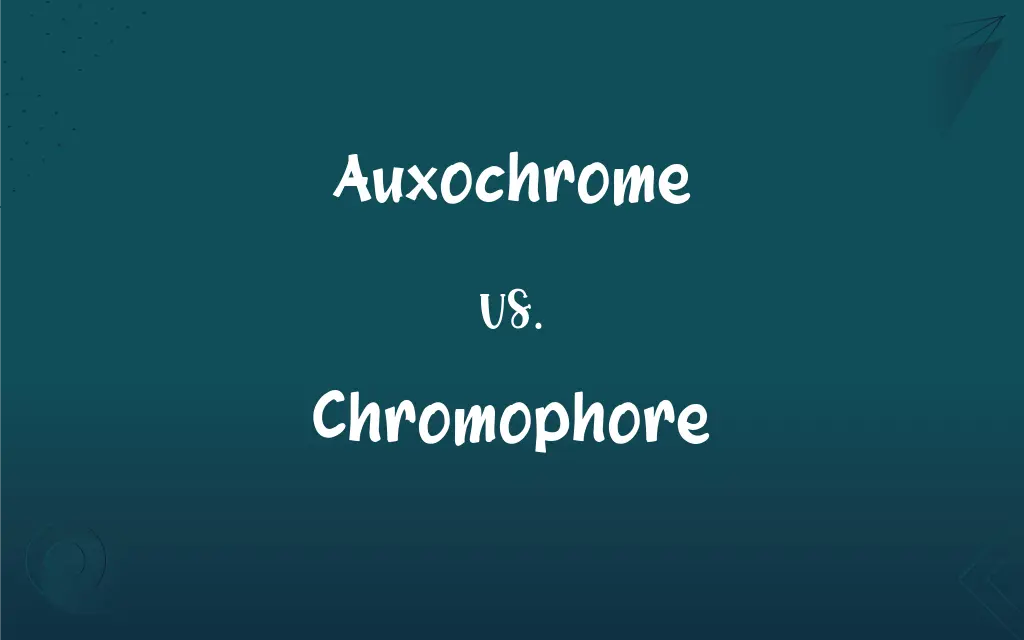Auxochrome vs. Chromophore: What's the Difference?
Edited by Aimie Carlson || By Harlon Moss || Published on February 26, 2024
A chromophore is a part of a molecule responsible for its color, while an auxochrome is a group that modifies the molecule's ability to absorb light.

Key Differences
A chromophore is a molecular fragment that absorbs certain wavelengths of light and gives color to the molecule. Auxochromes, on the other hand, are functional groups attached to the chromophore that alter the molecule's ability to absorb light, often intensifying or changing the color.
Chromophores are the central part of dyes and pigments and determine the basic color a substance displays. Auxochromes, while they don't impart color by themselves, modify the chromophore's light absorption characteristics, affecting the hue and intensity of the color.
The function of a chromophore is to absorb visible light, leading to coloration, based on the wavelengths it absorbs and those it reflects. Auxochromes can change the wavelength range absorbed by the chromophore, thereby modifying the color properties of the compound.
Common chromophores include various ring structures like benzene, while typical auxochromes include groups like -OH (hydroxyl) and -NH2 (amino). The presence of auxochromes in a molecule with a chromophore can shift the light absorption to longer wavelengths, a phenomenon known as bathochromic shift.
Chromophores are responsible for the color of compounds, and auxochromes are assistants that modify this color. The interaction between chromophores and auxochromes in a molecule is crucial for the design and function of dyes in various industries.
ADVERTISEMENT
Comparison Chart
Aspect of Comparison
Auxochrome
Chromophore
Role in Molecule
Modifies absorption properties of chromophore
Responsible for molecule's color
Direct Impact on Color
Does not impart color by itself
Directly responsible for color
Function
Alters light absorption, affecting color hue
Absorbs visible light, leading to coloration
Example Groups
-OH (hydroxyl), -NH2 (amino)
Benzene ring, C=C double bond
ADVERTISEMENT
Impact on Light Absorption
Can cause shifts in absorption wavelength
Determines wavelengths absorbed and reflected
Auxochrome and Chromophore Definitions
Auxochrome
Commonly -OH or -NH2 groups in dye molecules.
The amino auxochrome shifted the dye's color to a redder hue.
Chromophore
The part of a molecule responsible for color.
The chromophore in the pigment absorbs blue light, making it appear yellow.
Auxochrome
A group that modifies a molecule's light absorption.
The hydroxyl auxochrome in the dye alters its color absorption.
Chromophore
Absorbs specific wavelengths of visible light.
The chromophore's absorption of red wavelengths gives the compound a green appearance.
Auxochrome
Does not impart color but affects color intensity.
Adding an auxochrome intensified the fabric dye's color.
Chromophore
Central to the coloration in dyes and pigments.
The chromophore in this dye is responsible for its brilliant hue.
Auxochrome
Auxiliary groups attached to a chromophore.
The molecule's auxochrome altered its light absorption spectrum.
Chromophore
Often contains conjugated double bonds.
The chromophore's conjugated system is key to its vibrant color.
Auxochrome
Can cause bathochromic shift in absorption.
The auxochrome caused a noticeable bathochromic shift in the pigment.
Chromophore
Reflects certain light wavelengths, leading to color.
The chromophore in the flower's pigment reflects red, giving it its characteristic color.
Auxochrome
Any atom or group which, when added to a chromophore, causes a bathochromic shift in its spectrum
Chromophore
Any of various chemical groups that absorb light of certain wavelengths and when present in an organic compound, such as a dye or pigment, are responsible for the color of the compound.
Chromophore
(chemistry) that part of the molecule of a dye responsible for its colour
Chromophore
(chemistry) (more generally) the group of atoms in a molecule in which the electronic transition responsible for a given spectral band is located
Chromophore
Any chemical group or residue (as NO2; N2; or O2) which imparts some decided color to the compound of which it is an ingredient.
Chromophore
The chemical group that gives color to a molecule
FAQs
What is an auxochrome in chemistry?
It's a group in a molecule that modifies its light absorption and color intensity.
What does a chromophore do?
A chromophore absorbs specific wavelengths of light, giving color to the molecule.
Are chromophores found in all colored compounds?
Yes, all colored compounds have a chromophore that determines their color.
Do auxochromes always increase color intensity?
Mostly, but their main role is to modify the chromophore's light absorption, which can also shift color.
Can adding an auxochrome to a molecule make it colorless?
No, an auxochrome itself doesn't make a molecule colorless; it modifies an existing chromophore's effect.
Can an auxochrome function alone to give color?
No, auxochromes need to be attached to a chromophore to affect color.
How does an auxochrome affect a dye?
It can intensify the dye's color or shift its hue.
What is an example of a chromophore in nature?
The beta-carotene pigment in carrots, with its conjugated double bonds, is a natural chromophore.
Can auxochromes change the color of a compound?
Yes, they can alter the color by modifying the light absorption properties of the chromophore.
Are chromophores responsible for the color of flowers?
Yes, chromophores in pigments give flowers their colors.
Can auxochromes be removed from a compound?
Yes, through chemical reactions, but this will change the compound's color properties.
What makes a molecule a chromophore?
The presence of a system of conjugated double bonds typically constitutes a chromophore.
Are chromophores visible to the naked eye?
The color they impart to a compound is visible, but the chromophore structure itself is microscopic.
Is a chromophore a specific structure?
It's not a specific structure but rather a part of a molecule that absorbs light, which can vary in structure.
Do auxochromes absorb light?
Auxochromes influence how a chromophore absorbs light but don't typically absorb light independently.
How does an auxochrome cause a bathochromic shift?
By changing the electron distribution in the chromophore, shifting the absorption to longer wavelengths.
Can the same auxochrome have different effects on different chromophores?
Yes, the effect of an auxochrome can vary depending on the chromophore it's attached to.
Do all chromophores absorb visible light?
Chromophores absorb various light wavelengths, but those absorbing visible light are responsible for perceived colors.
Are chromophores important in textile industries?
Absolutely, they are crucial in determining the colors of dyes used in textiles.
Can a chromophore be artificially created?
Yes, chromophores can be synthesized for use in various artificial dyes and pigments.
About Author
Written by
Harlon MossHarlon is a seasoned quality moderator and accomplished content writer for Difference Wiki. An alumnus of the prestigious University of California, he earned his degree in Computer Science. Leveraging his academic background, Harlon brings a meticulous and informed perspective to his work, ensuring content accuracy and excellence.
Edited by
Aimie CarlsonAimie Carlson, holding a master's degree in English literature, is a fervent English language enthusiast. She lends her writing talents to Difference Wiki, a prominent website that specializes in comparisons, offering readers insightful analyses that both captivate and inform.
































































